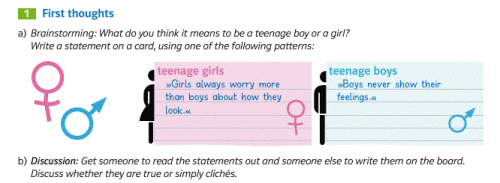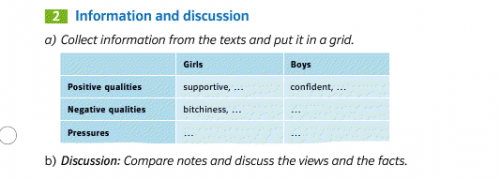Cross-posted at Jezebel.
Andi S.-R. noticed an interesting segment in a German textbook used to teach English. In the last few years, 12th-grade English classes have started including a section about gender, so textbooks have added chapters on the topic. Andi found a supplement from Klett, one of the major German publishers of educational materials, provided a supplement for covering gender that included a brainstorming exercises. While the idea was to foster discussion about gender stereotypes, Andi questions whether the sample comments provided as examples would help with that goal or would prime students to focus on stereotypical behavior by providing it as a model:
A second section helpfully suggests “bitchiness” as a quality students might associate with girls:
Again, the idea is to promote discussion, an excellent goal. But Andi succinctly points out the potential pitfalls of such a superficial approach:
…it’s unclear how students are supposed to know if these are “views” or “facts”, and having a discussion based on gut-feeling alone seems only likely to reinforce and teach as “facts” those stereotypes the students are familiar with, anyway.



Comments 20
Greg — March 18, 2011
Is that really the whole chart for #2? They couldn't come up with a negative quality for boys? Even a stereotypical one?
Lars Fischer — March 18, 2011
I agree that including discussion of gender, gender roles and social gender expectations in classes in an excellent idea. I also agree there's a risk of enforcing normative roles rather than encouraging student to reflect and challenge.
How this works out depends a lot on how the teacher introduce the topic and mediate the discussion. It would be useful to see if there's a "teachers manual" (there often is) for this textbook, and what it says.
It would also be useful to have some actual text with a few examples of stereotypical roles and expectation the effect they have.
Casey — March 18, 2011
Isn't that the Teacher's responsibility to demonstrate the difference between a view and a fact? I mean, it's not like the text can handle every answer thrown at it.
Luey — March 18, 2011
I teach an online associate's degree course about race, and I used to have a similar assignment. Students were directed to take traits from a list and apply them to the group that encompasses the stereotype. (Full disclosure: I didn't create the assignment, it was in the recommended course material provided by the school.
I dropped the assignment because it did exactly what the post fears. It didn't feel like students were learning, it felt like they were parroting what they already thought about certain ethnic groups. Also, discussion about the assignment was difficult because it is an online course.
I feel that the example above is similarly misguided.
Roschelle — March 19, 2011
Bitchiness? .... seriously????
Roschelle — March 19, 2011
oh i understand the terminology and definition. the tragedy is it's existence as a word defining "typically" female indirect aggression.
Shane — March 19, 2011
The purpose of these gender-related sections is not so much to facilitate truly meaningful discussion of gender issues. Their main purpose is to 'make' gender an 'issue' to students. Whether the discussion is done poorly or reinforces certain stereotypes or breaks them down is not the point. The teacher (whether right or wrong) facilitating the discussion will ultimately provide the opinion with the greatest weight and will influence the students the most.
This is simply social conditioning in the classroom which has always been done in one form or another. The purpose is to make the students hyper-aware of different sociological conditions such as gender (in this case), race, or sexual orientation. All the while, the students were supposed to be learning English... but were instead made into guinea pigs for educators.
Again, it is not that this gender related section is somehow 'based on facts' or is representative of good material. That the subject is introduced is the 'good' for the educator and will help to facilitate the educator's effort to socially engineer the opinions and behaviors of her/his students.
MPS — March 20, 2011
It makes perfect sense that women worry about their looks more then men; because men judge women based on their looks more than women judge men based on their looks. It also makes sense that men worry more about their income than women. Indeed this might partly explain the balance of time men/women spend working/grooming.
This is not to say that that this arrangement (the different ways in which men and women value each other) is *natural* or *good*. Just trying to get at the deeper cause to stereotypes that might be true (in a statistical sense).
Ceiling Cat — March 20, 2011
The "bitchiness" just enrages me. It's an insult against womankind right in the school book.
I mean, come on! Who sees a girl and thinks "bitch"? Not a person who should be composing school books!
mf — March 21, 2011
Interesting post. Recently, in feminist websites and the general media, German school book publisher Klett was also criticised because it published gendered books with exercises for school-children:
e.g. mathematics for girls (there's another one for boys) http://www.klett.de/sixcms/list.php?page=suche&modul=produktdetail&isbn=3-12-561646-8
or writing themes for girls vs writing themes for boys. It seems to be a general strategy of Klett and Pons schoold publishers to point out gender differences. It is not astonishing for me to see that the same strategy is used for foreign language learning material. I think it is a dangerous tendency that school book publishers are reinforcing gender stereotypes so much.
Jess — April 11, 2011
I'm an esl teacher and had the same sort of exercise teaching stereotypes about nationalities. I used it for a few of my classes and then dropped it because the classes I was teaching were just one nationality and all had similar(often nasty) ideas about other nationalities. People's stereotypes come out in class whether you discuss them or not. I think the way to handle stereotypes in the classroom is to demonstrate through your own responses. When students make racist, sexist, homophobic, or ethnocentric remarks, it's important not to laugh or get angry. I think it's better to bring materials into class which contradict their stereotypes. When talking about marriage, relationships- include different laws/definitions- not just man/woman. Use gender neutral words when possible, and use he/she examples with a variety of jobs/income situations, parenting situations.
I won't use that brainstorming stereotype discussion exercise again anytime soon because I don't want to get into lecturing or leading the students towards an opinion of right or wrong out of left field, just because I'm the teacher. I'd rather bring in historical materials, literature, or news.
Jadey-brown — January 16, 2013
It is of course useful to discuss gender stereotypes (and how they influence us) in a lesson - however this discussion should be structured and develop certain points such as the level of misogyny within society. A textbook which labels women 'bitchy' is not in any way condusive of learning, it simply brainwashes yet another generation into believing women are subordinate. Also, the current generation has plenty of ingrained knowledge of gender stereotypes; they have more access to media than any previous generation and are therefore filled with these ideas constantly.